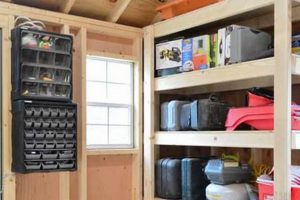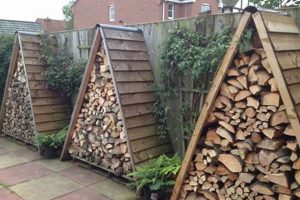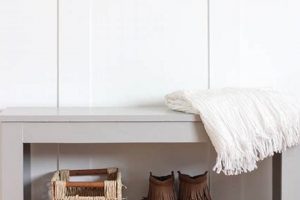A bed frame design incorporating a raised, level surface for mattress support, combined with self-assembled storage components, offers a practical solution for maximizing space utilization. This type of furniture often includes drawers, shelves, or compartments built directly into the bed’s structure. An example would be a wooden frame featuring pull-out drawers along the sides for clothing or bedding.
The integrated storage provides a significant advantage, particularly in smaller living spaces where efficient organization is paramount. This approach reduces the need for additional furniture, minimizing clutter and optimizing floor area. Historically, resourceful individuals have adapted existing bed frames to incorporate storage, leading to the development of purpose-built designs that are now widely available or customizable.
Subsequent sections will explore different design approaches for constructing such a space-saving bed frame, available materials, and techniques for ensuring structural integrity and aesthetic appeal. Considerations for accessibility, safety, and customization options will also be addressed, empowering individuals to create a personalized and functional bedroom centerpiece.
Essential Considerations for Integrated Bed Frame Construction
The following guidelines provide crucial considerations for successfully designing and implementing a self-assembled bed frame with integrated storage. Careful planning and execution are paramount for achieving a functional and structurally sound result.
Tip 1: Material Selection: Prioritize durable materials such as solid wood or engineered wood composites (e.g., plywood, MDF) with sufficient thickness to support the mattress and anticipated storage load. Consider the material’s resistance to warping, moisture, and pests.
Tip 2: Structural Integrity: Employ robust joinery techniques, such as mortise and tenon joints, dowel joints, or appropriately sized screws and bolts, to ensure the frame’s stability and prevent sagging or collapse over time. Reinforce corners and stress points with metal brackets or additional bracing.
Tip 3: Weight Distribution: Design the storage compartments to distribute weight evenly across the frame. Avoid concentrating heavy items in one area, which can compromise structural integrity. Consider incorporating internal support structures for larger or deeper storage spaces.
Tip 4: Access and Ergonomics: Carefully plan the access points for storage compartments to ensure ease of use and prevent strain or injury. Consider the height of the bed frame and the reach required to access items. Incorporate smooth-gliding hardware for drawers and doors.
Tip 5: Safety Considerations: Implement safety features such as rounded edges, recessed hardware, and secure locking mechanisms to prevent accidental injuries. Ensure that all materials and finishes are non-toxic and compliant with relevant safety standards.
Tip 6: Ventilation: Provide adequate ventilation within storage compartments to prevent moisture buildup and mold growth. Consider incorporating ventilation holes or using breathable materials for drawer bottoms and backs.
Tip 7: Space Optimization: Design storage compartments to maximize space utilization. Consider using adjustable shelves, dividers, or organizers to customize the storage space to fit specific needs.
Adhering to these guidelines will contribute to a robust, safe, and efficient bed frame incorporating storage. This careful approach will ensure longevity and practicality.
The subsequent sections will delve into specific design plans and step-by-step construction processes for integrated storage bed frames.
1. Space Optimization
Space optimization is a fundamental driver in the adoption of self-assembled storage bed frames. The core principle involves maximizing usable storage capacity within the existing bedroom footprint. A direct consequence of this approach is the reduction in the need for additional storage furniture, such as dressers or chests, thus freeing up floor space. The effective implementation of integrated storage directly impacts the room’s perceived spaciousness and overall functionality.
Consider a small apartment where every square foot is valuable. A standard bed frame consumes a significant portion of the available floor area. By integrating storage compartments directly into the platform, the bed frame simultaneously serves as sleeping platform and storage unit. For example, drawers built into the sides of the frame can house clothing, linens, or personal belongings, eliminating the need for a separate dresser and creating more open space within the room. Similarly, a lift-up platform can conceal a large storage area beneath the mattress, suitable for storing seasonal items or bulky objects.
In summary, space optimization is not merely a desirable attribute of platform bed frame construction; it is a core design principle that directly influences its practicality and effectiveness. A thorough understanding of this connection is crucial for individuals seeking to maximize storage potential in limited spaces. The strategic integration of storage into bed frame designs allows for efficient use of vertical and horizontal space, leading to a more organized and functional living environment.
2. Material Durability
Material durability is a critical determinant of the long-term success and functionality of a self-assembled storage bed frame. The frame must withstand the combined weight of the mattress, occupants, and stored items without structural failure or significant degradation. Selection of inadequate materials inevitably leads to sagging, cracking, joint separation, and ultimately, the compromised utility of both the bed and its storage capacity. For instance, using low-density particleboard for drawer bottoms will cause them to bow and potentially detach under the weight of clothing or books, rendering the storage space unusable.
Employing high-quality, durable materials, such as solid hardwood or appropriately graded plywood, directly translates to increased longevity and stability. Solid wood, with its inherent strength and resistance to warping, provides a robust foundation for the bed frame. Plywood, composed of multiple layers of wood veneer bonded together, offers excellent dimensional stability and load-bearing capacity, particularly when constructed with hardwoods like birch or maple. The use of durable joinery methods, coupled with resilient materials, ensures that the frame maintains its structural integrity over years of use. For example, a frame constructed from kiln-dried oak, joined with mortise and tenon joints reinforced with epoxy, will exhibit superior resistance to stress and wear compared to a frame built with cheaper, less durable materials.
In conclusion, material durability is not simply a desirable characteristic, but a fundamental requirement for a functional and long-lasting bed frame incorporating storage. The choice of materials directly impacts the bed’s ability to support weight, resist wear and tear, and provide reliable storage over time. Investing in durable materials and employing robust construction techniques is a prudent strategy that yields significant long-term benefits and avoids the costly and inconvenient consequences of premature structural failure. The understanding of this connection ensures that the constructed frame meets its intended purpose safely and efficiently.
3. Design Stability
Design stability is paramount in the construction of a self-assembled storage bed frame, serving as the foundational element that guarantees both safety and longevity. It is not merely an aesthetic consideration; rather, it is the structural backbone that enables the bed to withstand constant use and maintain its integrity over time. Failure to prioritize design stability can lead to compromised functionality, potential safety hazards, and ultimately, a reduced lifespan for the furniture.
- Joint Integrity
The strength and reliability of the joints that connect the various components of the bed frame are crucial. Techniques such as mortise and tenon, dovetail, or robust screw and bolt connections are necessary to prevent movement or separation under stress. Inadequate joint construction will result in wobbling, creaking, and eventual structural failure, particularly under the weight of a mattress, occupants, and stored items. An example of proper joint integrity is the use of interlocking dovetail joints on drawer boxes, which resist pulling forces and maintain the drawer’s rectangular shape over time.
- Load Distribution
The design must account for the distribution of weight across the entire frame, preventing localized stress concentrations that can lead to warping or breakage. This often involves strategically placed support beams, reinforced corners, and appropriately sized materials. For instance, a bed frame with a central support beam running the length of the platform will distribute the weight of the mattress and occupants more evenly, reducing the risk of sagging in the middle. Conversely, a design lacking adequate load distribution will likely experience premature wear and tear, leading to instability and potential collapse.
- Material Selection Relative to Span
The choice of materials must be appropriate for the span (distance between supports) required in the design. Materials with inadequate strength or stiffness will deflect or bend excessively, compromising the structural integrity of the frame. Using thick, solid wood for long spans will minimize deflection, while thinner materials may require additional supports or bracing. For example, a headboard constructed from thin plywood without sufficient internal bracing will be prone to warping or flexing under pressure, whereas a solid wood headboard of the same dimensions will maintain its shape and stability.
- Fastener Selection and Placement
The selection and placement of fasteners (screws, bolts, nails) must be carefully considered to ensure adequate holding power and prevent loosening over time. Using screws that are too short or too small in diameter will compromise the joint’s strength, while improper placement can lead to splitting or weakening of the surrounding material. Strategically placing fasteners along the grain of the wood and using appropriate screw types (e.g., wood screws for wood, lag bolts for heavy-duty connections) will enhance the overall stability of the bed frame. For instance, using coarse-threaded wood screws to attach the side rails to the headboard and footboard will provide a more secure connection than using finishing nails.
In summary, design stability is not a standalone element but rather a holistic approach that integrates material selection, joint construction, load distribution, and fastener selection to create a robust and dependable self-assembled storage bed frame. A well-engineered design ensures that the bed frame can withstand the rigors of daily use, providing a safe and comfortable sleeping surface while effectively utilizing storage space. It is an investment in the longevity and functionality of the furniture, preventing costly repairs or replacements in the future and supporting the intended purpose of combining sleep and storage. The design aspect and its stability must always be prioritized for optimal results.
4. Accessibility Ease
Accessibility ease, within the context of a self-assembled storage bed frame, denotes the user’s ability to readily access and utilize the storage compartments without undue physical strain or inconvenience. This factor directly influences the practical value and usability of the integrated storage system, impacting user satisfaction and the overall effectiveness of the design.
- Drawer Glide Mechanisms
The type and quality of drawer glide mechanisms employed significantly affect accessibility. Full-extension ball-bearing glides enable complete drawer access, allowing users to reach items at the back without difficulty. Conversely, friction-based or partial-extension glides may limit access and require awkward maneuvering, particularly when drawers are heavily loaded. The implementation of smooth and reliable glide mechanisms is crucial for maximizing the usability of drawer-based storage.
- Lid Support Systems
For storage compartments accessed via lift-up lids, the inclusion of appropriate support systems is essential. Gas struts or spring-loaded hinges provide controlled opening and closing, preventing the lid from slamming shut and potentially causing injury. These systems also reduce the physical effort required to lift and hold the lid open, facilitating hands-free access to the storage space. The absence of adequate lid support can render the storage compartment difficult and potentially hazardous to use.
- Compartment Height and Reach
The height and depth of storage compartments directly impact accessibility. Compartments positioned too low to the ground may require users to bend or kneel uncomfortably, while excessively deep compartments may necessitate reaching far inside, potentially straining the back or shoulders. Optimizing compartment dimensions to accommodate common storage items while maintaining a comfortable reach range is vital for ensuring ease of use.
- Handle and Grip Design
The design of handles, knobs, or grip points significantly influences the ease with which drawers and lids can be opened and closed. Ergonomic handles that provide a secure and comfortable grip reduce the force required to operate storage compartments, particularly when heavily loaded. Conversely, poorly designed handles or the absence of any grip points can make it difficult to access storage, especially for individuals with limited hand strength or dexterity.
These facets highlight the importance of considering accessibility ease during the design and construction of a self-assembled storage bed frame. A well-designed system prioritizes user comfort and convenience, ensuring that the integrated storage is not only functional but also readily accessible and easy to use for individuals of varying physical abilities. Attention to detail in these areas directly translates to enhanced user satisfaction and the realization of the full potential of a bed frame offering accessible storage solutions.
5. Safety Standards
Adherence to safety standards is not merely a recommendation but a crucial prerequisite for the successful and responsible construction of a self-assembled storage bed frame. The inherent risks associated with elevated sleeping surfaces and enclosed storage spaces necessitate rigorous attention to established safety guidelines. Failure to comply with these standards can result in injuries, property damage, and potential legal liabilities. A primary concern revolves around structural integrity; a poorly constructed frame lacking adequate support can collapse under load, causing harm to the occupant. Similarly, the use of flammable materials or finishes can pose a fire hazard, particularly in confined storage spaces. These examples underscore the direct correlation between safety standard compliance and the mitigation of potential risks.
The practical significance of understanding and implementing relevant safety standards extends beyond immediate injury prevention. Proper ventilation within storage compartments is essential to prevent the buildup of moisture and the proliferation of mold or mildew, which can pose health risks, particularly for individuals with allergies or respiratory sensitivities. Furthermore, the selection of non-toxic materials and finishes is crucial to avoid exposure to harmful chemicals through direct contact or off-gassing. Edges should be rounded to minimize the risk of impact injuries. Hardware like drawer pulls and hinges must be secured tightly and regularly inspected to avoid becoming loose and creating a potential hazard. The Consumer Product Safety Commission (CPSC) offers guidelines and regulations relevant to furniture safety, providing a valuable resource for self-builders. Conforming to these standards ensures the long-term health and well-being of the bed’s users.
In summary, integrating safety standards into the design and construction of a bed frame is an investment in well-being and peace of mind. Challenges may arise in interpreting and applying complex regulations, particularly for individuals with limited construction experience. However, resources such as online tutorials, building codes, and expert consultations can provide valuable guidance. Prioritizing safety standards minimizes risk, maximizes the longevity of the furniture, and aligns with the ethical responsibility to create a safe and healthy living environment. The principles outlined directly contribute to the overall theme of a functional, durable, and secure storage solution.
6. Construction Simplicity
Construction simplicity, in the context of self-assembled storage bed frames, refers to the degree to which a design can be readily executed by individuals with limited prior experience in woodworking or furniture construction. It is a critical factor influencing project feasibility, time investment, and the likelihood of successful completion. Designs lacking in construction simplicity often lead to frustration, errors, and ultimately, project abandonment.
- Component Count Minimization
Reducing the number of individual components simplifies the construction process by decreasing the number of cuts, joints, and assembly steps required. A design utilizing fewer, larger pieces minimizes complexity and reduces the potential for errors. For example, a platform bed frame constructed from four solid wood side rails and a pre-fabricated plywood platform is significantly simpler to build than one composed of numerous smaller slats, individual support beams, and intricate joinery.
- Straightforward Joinery Techniques
Employing basic joinery techniques, such as butt joints reinforced with screws or pocket-hole joinery, simplifies assembly and reduces the need for specialized tools or skills. Complex joinery methods like mortise and tenon or dovetail joints, while offering superior strength, require greater precision and expertise. A design relying on easily executed joints makes the project more accessible to a wider range of builders.
- Clear and Concise Instructions
Comprehensive and clearly written instructions, accompanied by detailed diagrams or illustrations, are essential for guiding builders through the construction process. Step-by-step guidance, with emphasis on critical measurements and assembly sequences, reduces the likelihood of errors and enhances project understanding. Instructions lacking clarity or completeness can lead to confusion, frustration, and potential missteps.
- Standard Material Dimensions
Designing the bed frame to utilize standard lumber dimensions minimizes the need for extensive cutting and milling, reducing both time investment and the risk of errors. Utilizing readily available lumber sizes avoids the complexities of sourcing specialized materials or performing intricate shaping operations. This standardization streamlines the construction process and makes the project more accessible to individuals with limited access to woodworking tools or equipment.
These facets collectively contribute to the overall construction simplicity of a storage bed frame. A design prioritizing these elements is more likely to be successfully executed by individuals with varying levels of woodworking experience, resulting in a functional and aesthetically pleasing piece of furniture. Consideration of construction ease makes storage bed frame designs more accessible for the average builder.
7. Cost Effectiveness
Cost effectiveness is a primary driver for individuals choosing to construct a self-assembled storage bed frame. The direct financial investment in raw materials and hardware often presents a significantly lower expenditure than purchasing a comparable pre-fabricated bed frame with integrated storage. This cost differential is particularly pronounced when considering high-quality materials or custom design features often absent in mass-produced furniture. The ability to directly control material selection allows for budget optimization, balancing durability and aesthetic considerations with affordability. For instance, an individual may choose to utilize reclaimed lumber for certain components, reducing material costs while imparting a unique aesthetic.
The inherent labor involved in self-assembly becomes the primary trade-off for reduced material costs. While requiring time and effort, this self-investment eliminates the markup associated with professional furniture manufacturing and retail. Moreover, the project can be phased, allowing for material purchases to be staggered according to budgetary constraints. Furthermore, construction may enable the repurposing of existing materials or tools, further minimizing upfront expenses. Individuals with existing woodworking skills or access to shared workshop facilities benefit disproportionately from this cost-saving aspect. An illustrative example is the adaptation of an existing platform bed frame to incorporate drawers, utilizing repurposed drawer fronts and salvaged hardware. The initial investment of labor yields a long-term return in the form of a customized and cost-effective storage solution.
In summary, the decision to pursue self-assembled storage bed construction hinges upon a careful evaluation of cost effectiveness. The lower initial outlay for materials is often offset by the investment of time and labor. However, the ability to control material selection, customize design, and potentially repurpose existing resources often results in a significantly more affordable and personalized storage solution compared to purchasing a pre-fabricated alternative. Understanding this balance empowers individuals to make informed decisions aligned with their budgetary constraints and practical skills, directly contributing to the feasibility of the project. Cost must be the primary aspect that the average builder understands.
Frequently Asked Questions
The following addresses common inquiries regarding design, construction, and implementation aspects of storage bed frames.
Question 1: What is the minimum recommended lumber thickness for constructing a platform bed frame designed to support both a mattress and integrated storage compartments?
The minimum recommended lumber thickness is 1.5 inches (nominal 2-inch). This dimension provides adequate structural support to prevent sagging or collapse under the combined weight of the mattress, occupants, and stored items. Lower lumber thicknesses compromise structural integrity and present a safety hazard.
Question 2: How should ventilation be incorporated into enclosed storage compartments to mitigate the risk of mold or mildew growth?
Ventilation can be achieved through the inclusion of strategically placed ventilation holes or the utilization of breathable materials for drawer bottoms and backs. Ventilation holes, typically 1-2 inches in diameter, should be positioned to allow for cross-ventilation within the compartment. Breathable materials, such as woven fabrics or perforated panels, promote air circulation and reduce moisture accumulation.
Question 3: What joinery techniques are best suited for assembling a durable and stable platform bed frame with limited woodworking experience?
Butt joints reinforced with screws or pocket-hole joinery offer a balance of simplicity and strength suitable for novice woodworkers. These techniques require minimal specialized tools and provide sufficient structural integrity for most bed frame applications. Careful alignment and the use of appropriate screw lengths are essential for achieving a secure and stable connection.
Question 4: What safety features should be incorporated into the design of storage compartments to prevent accidental injuries?
Safety features include rounded edges, recessed hardware, and secure locking mechanisms. Rounded edges minimize the risk of impact injuries, particularly for children. Recessed hardware prevents snagging or scratching. Secure locking mechanisms prevent drawers or lids from opening unexpectedly, preventing items from falling out and causing injury.
Question 5: How can load distribution be optimized to prevent sagging or warping of the platform bed frame over time?
Load distribution can be optimized through the strategic placement of support beams, reinforced corners, and the utilization of appropriately sized materials. Support beams running the length of the platform distribute weight evenly, preventing sagging in the middle. Reinforced corners provide additional support at stress points. Selecting materials with adequate strength and stiffness ensures that the frame maintains its shape and stability over time.
Question 6: What types of finishes are recommended for a self-assembled storage bed frame to ensure both durability and compliance with safety standards?
Non-toxic, water-based finishes are recommended for bed frames due to their low VOC (volatile organic compound) content and ease of application. These finishes provide a durable protective layer while minimizing exposure to harmful chemicals. Ensure that the chosen finish is specifically designed for interior wood surfaces and complies with relevant safety standards for furniture finishes.
Prioritizing safety, durability, and ease of construction is essential for a successful outcome. The information provided serves as a foundation for informed decision-making throughout the building process.
Subsequent sections will provide detailed design plans and step-by-step instructions for constructing a space-saving bed frame.
Concluding Remarks
This exploration of self-assembled bed frames with integrated storage has underscored the importance of meticulous planning, material selection, and adherence to established construction and safety standards. A durable, safe, and functional implementation requires a thorough understanding of structural principles, load distribution, and accessibility considerations. Designs should prioritize both practical utility and adherence to best practices, ensuring long-term usability and minimizing potential risks.
The integration of elevated sleeping surfaces and storage spaces presents unique challenges requiring careful consideration. Ultimately, the success of projects hinges on a commitment to quality craftsmanship, thoughtful design choices, and a dedication to creating a secure and aesthetically pleasing living environment. The responsible application of the knowledge shared herein will yield furniture that is both practical and enduring.







